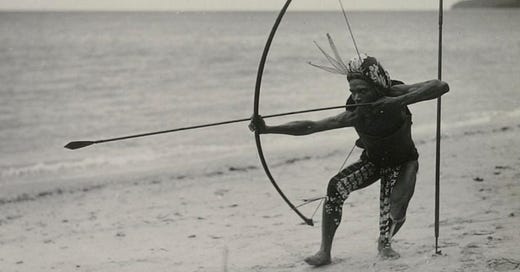Transmission #47: Slings and Arrows, Brian Eno, Angry Octopi and A New Climate Hope
Design, ideas and other flotsam
Hello. Welcome.
This is Transmissions by me, Marty Brown.
What is Transmissions? It’s an ongoing, (usually) fortnightly newsletter that collates some of the more interesting stories, links, quotes and other curios that float my way.
If you’re new here, then sign up now to get more of these in your inbox, and don’t forget to tell your friends!
Design
When Lethal Weapons Grew on Trees
Kris De Decker, Low Tech Magazine
In-depth essay about the construction of bows and arrows. There are hundreds of variations, but only a handful of unique and successful design approaches.
Essentially, there are two types of bows, opposites on a scale: the self-bow and the composite bow. Self-bows are made from a single stave of wood, while composite bows consist of several layers of various materials (usually wood, horn, and sinew). Other bows are somewhere in between. For example, laminated bows consist of several layers of the same material, and backed self-bows are hybrids between self-bows and composite bows. Self-bows dominated forested continents (Europe, the Americas, and Africa). Composite bows ruled in the drier regions (Middle East and Eurasia).
There are some truly beautiful examples of indigenous craftsmanship, below are cable-backed bowes, where imperfect wood is given additional strength and tension through the addition of intricately woven cables of twine.
Historic and prehistoric bows and arrows were entirely made from natural and locally available materials. These came from plants and trees (wood, cane, bamboo, flax), animals (tendon, bone, feathers, glue), and minerals (stone and metal points). Nowadays, just like 10,000 years ago, one can walk into a forest or any other natural environment with empty hands and come out with a functional weapon.
Ideas
Brian Eno Reveals the Hidden Purpose of All Art
David Marchese, New York Times
There’s an LCD Soundsystem song called ‘Losing My Edge’ in which the protagonist namechecks dozens of iconoclastic moments in late-20th century music/cultural history, and with a kind of wistful pride proclaims that he ‘was there.’
I was there in the Paradise Garage DJ booth with Larry Levan.
I was there in Jamaica during the great sound clashes.
I woke up naked on the beach in Ibiza in 1988.
Brian Eno is basically that guy. He was there. Glam rock, ambient music, pop, rock, oblique strategies, long-termism. And at 74, he still is there. He’s still doing fascinating projects, either musically or as a general purpose thinker and cultural provocateur.
Disregard the bombastic headline, this interview is a lot of Eno, just riffing wonderfully on unexpected subjects, like here:
NYT: Do you think we’re in a dull cultural moment?
Eno: I don’t, actually. Right now I see quite strong movement in some rather unexpected areas. A.S.M.R., this whispering thing, that’s incredibly promising. It’s quite counterintuitive. You get the idea that the trajectory of media is greater acceleration, louder, more surprises, and here you have millions of people sitting listening to somebody brushing their hair and whispering for 40 minutes. You have to take that on board as being one of the things that’s happening in culture and quite different from the story that we’re generally hearing.
Beyond Catastrophe: A New Climate Reality Is Coming Into View
David Wallace-Wells, New York Times
The annual climate summit COP27 has just wrapped up, with the usual finger pointing and buck passing, and not a lot of tangible progress. And with the goal of limiting warming to 1.5C almost certainly beyond possibility, it’s easy to feel defeatist.
But maybe we’re turning a corner. It’s a slow turn, and a large corner. But a corner nonetheless. David Wallace-Wells wrotes a book in 2017 called The Uninhabitable Earth, which painted a bleak and ghastly picture of the future – but in the 5 years since, he has recanted some of his more extreme scenarios because there have been significant signs of positive change.
One is our capacity to deal with disruption caused by a more erratic climate:
Some more sanguine climate observers often point out that even as we put ourselves in the path of extreme weather, deaths from natural disasters are not, in fact, growing — indeed, they have fallen, by an astonishing degree, from as much as an average of 500,000 deaths each year a century ago to about 50,000 deaths each year today (even as climate- and weather-related natural disasters have increased fivefold).
And another is the energy revolution:
Thanks to astonishing declines in the price of renewables, a truly global political mobilization, a clearer picture of the energy future and serious policy focus from world leaders, we have cut expected warming almost in half in just five years.
Including this jaw-dropper:
Globally, there are enough solar-panel factories being built to produce the necessary energy to limit warming to below two degrees.
It’s refreshing to have a break from doomerism, and a glimmer of hope that our collective future may not involve an uninhabitable earth after all.
Chart of the Week
Other
🌍 By 2100, Africa will be home to 40% of the world’s population. A strip of land between Lagos, and Abidjan in the Ivory Coast is projected to a sprawling megacity with a population in the order of half a billion people. Link
🦠 It was a pretty big deal for life on earth when single celled organisms evolved into multicellular creatures. Here, a lab experiment observes this happening in real-time. Link
🐦 McSweeney’s typically zesty and zeitgeisty take on the twitter implosion: what to do with your twitter jokes? Link
🐙 Sadly, the headline of this article is the best bit. But still, it’s a great headline from the NYTimes: “Sometimes This Octopus Is So Mad It Just Wants to Throw Something.” Link
👗 Street fashion photography is dying, because the internet is killing localised styles. We are entering a flat era of fashion. Link
💩 I, for one, will never tire of reading about fatbergs and the teams that crawl underground to destroy them. Link
🐛 More gross but engrossing content (see what I did there?). First sentence: ‘Glued to the inside of your mouth this very moment (there's a 50% chance) may be plump bacterial caterpillars.’ Read on if you dare. Link
Thanks for reading, I hope you’ve enjoyed it. See you in a fortnight for a very special end of year wrap!







Starting to feel about like the 'losing my edge' song of late. Eno's holding the torch (and more) for us all.